Abstract
1. We report a method for measuring the concentrations of haloperidol (HL) and its major active metabolite, reduced haloperidol (RHL), in human scalp hair. 2. Hair samples were obtained from 59 patients who had been taking HL at fixed daily doses for more than 4 months and whose compliance was good. A morning pre-dose plasma sample was also obtained from 48 of these patients. 3. The concentrations of HL and RHL in hair (ng mg-1 hair) correlated significantly both with the daily dose (micrograms kg-1 body weight) of HL (r = 0.682, P less than 0.001 for HL and r = 0.813, P less than 0.001 for RHL, n = 59) and with the trough concentration (ng ml-1) of the corresponding compound in plasma at steady state (r = 0.558, P less than 0.001 for HL and r = 0.563, P less than 0.001 for RHL, n = 48). The correlation coefficients were slightly higher using the sum of the concentrations of both substances in hair (r = 0.829 for the correlation with daily dose and r = 0.609 for that with trough concentration). 4. Hair from other patients, in whom the dosage of HL had been changed within a few months prior to sampling, was sectioned into 1 cm-long portions successively from the roots and the concentrations of both compounds in each portion were measured. Assuming a growth rate of 1-1.5 cm/month, a history of individual dosage could be deduced in all patients from the distribution of the drug and metabolite along the single hair length.(ABSTRACT TRUNCATED AT 250 WORDS)
Full text
PDF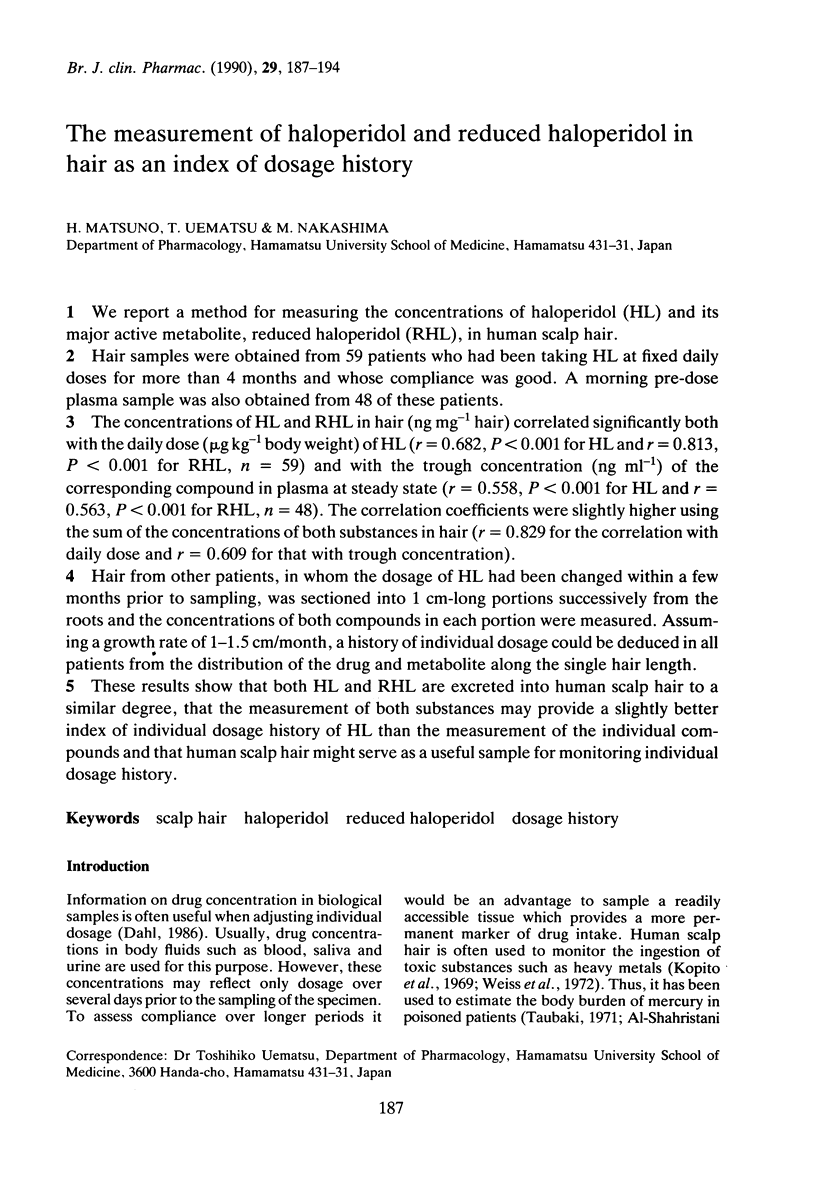
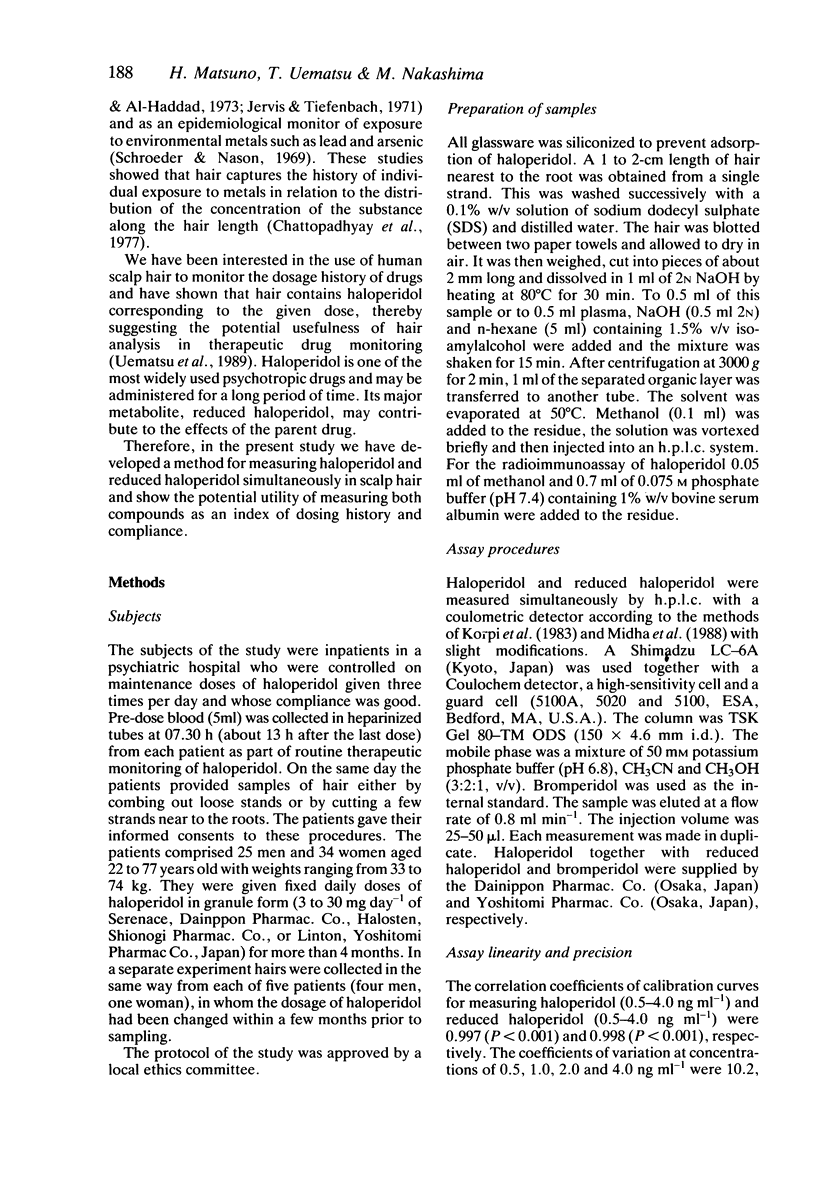
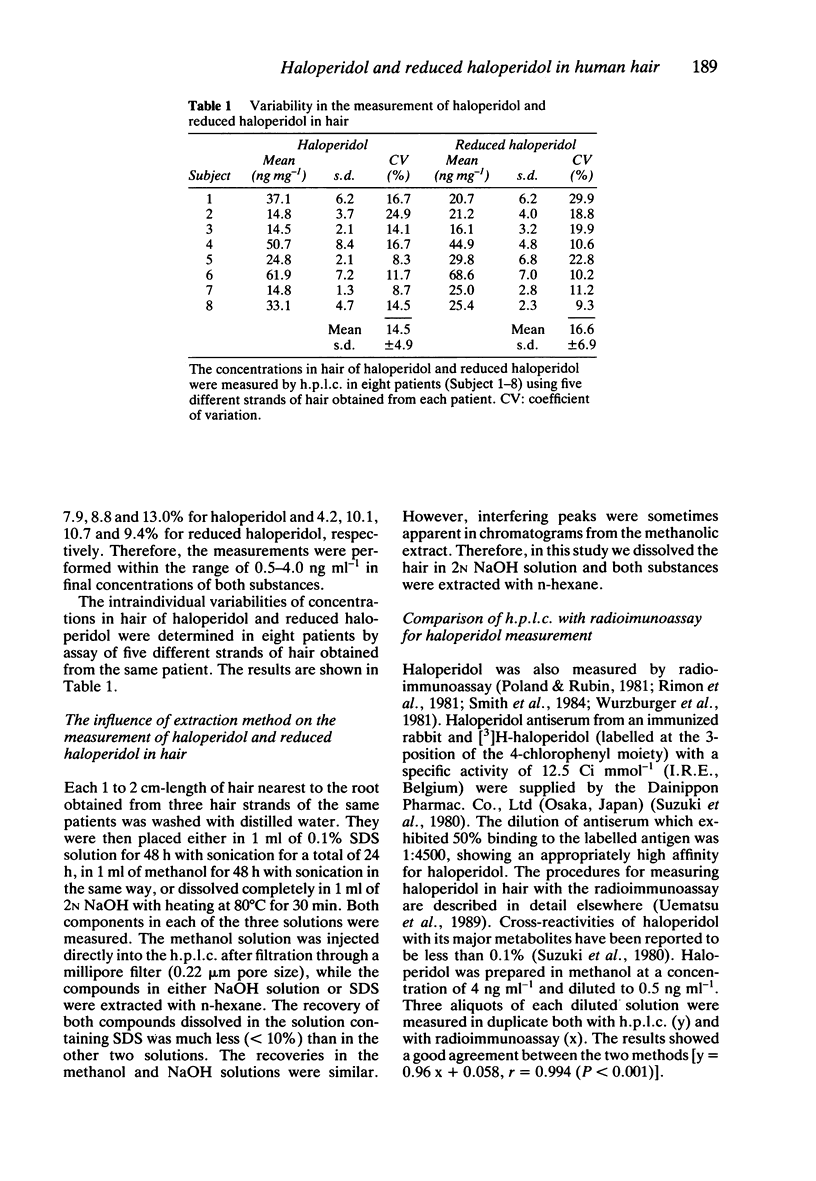
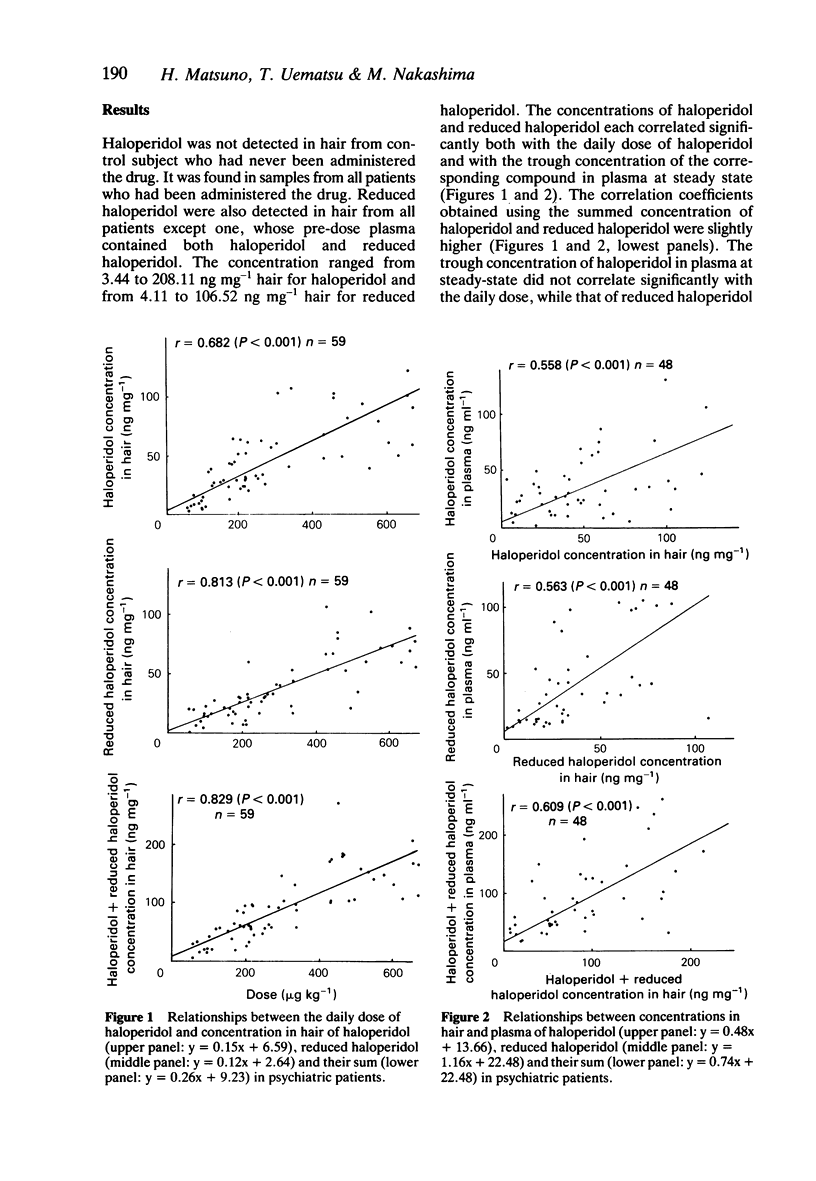

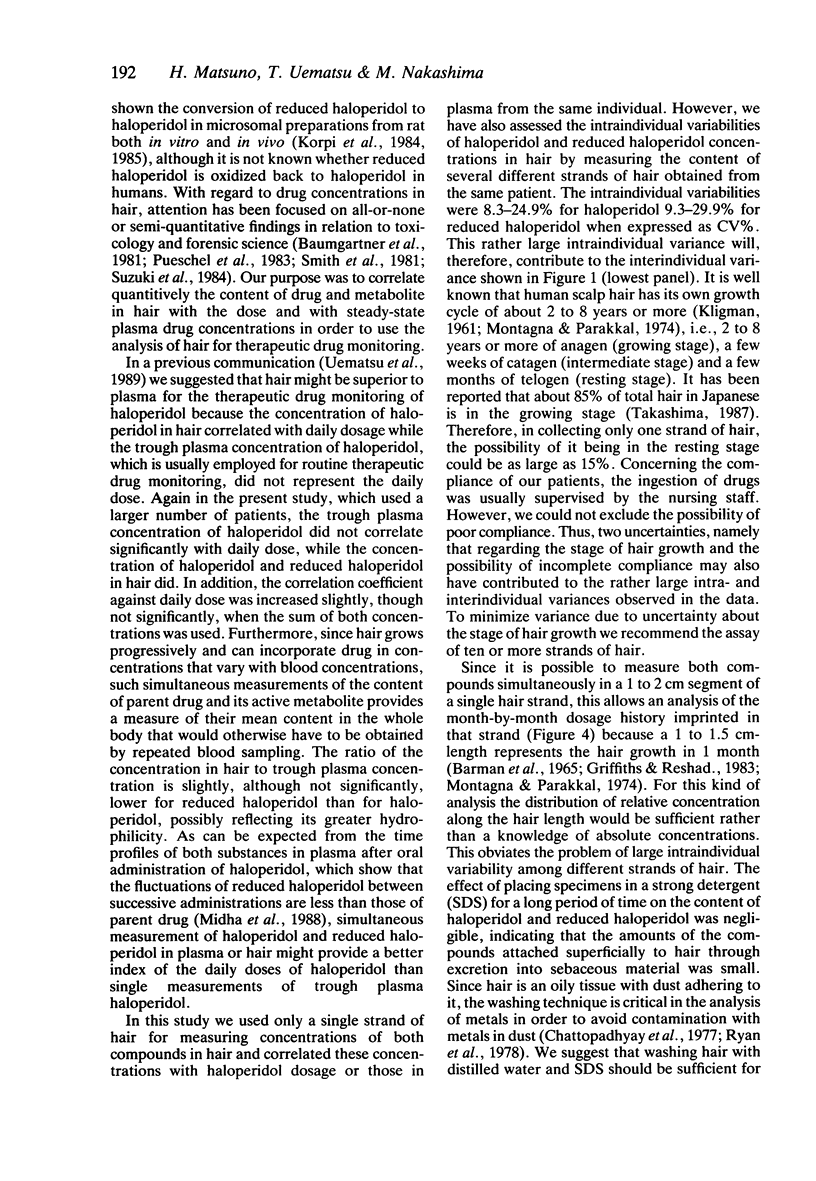
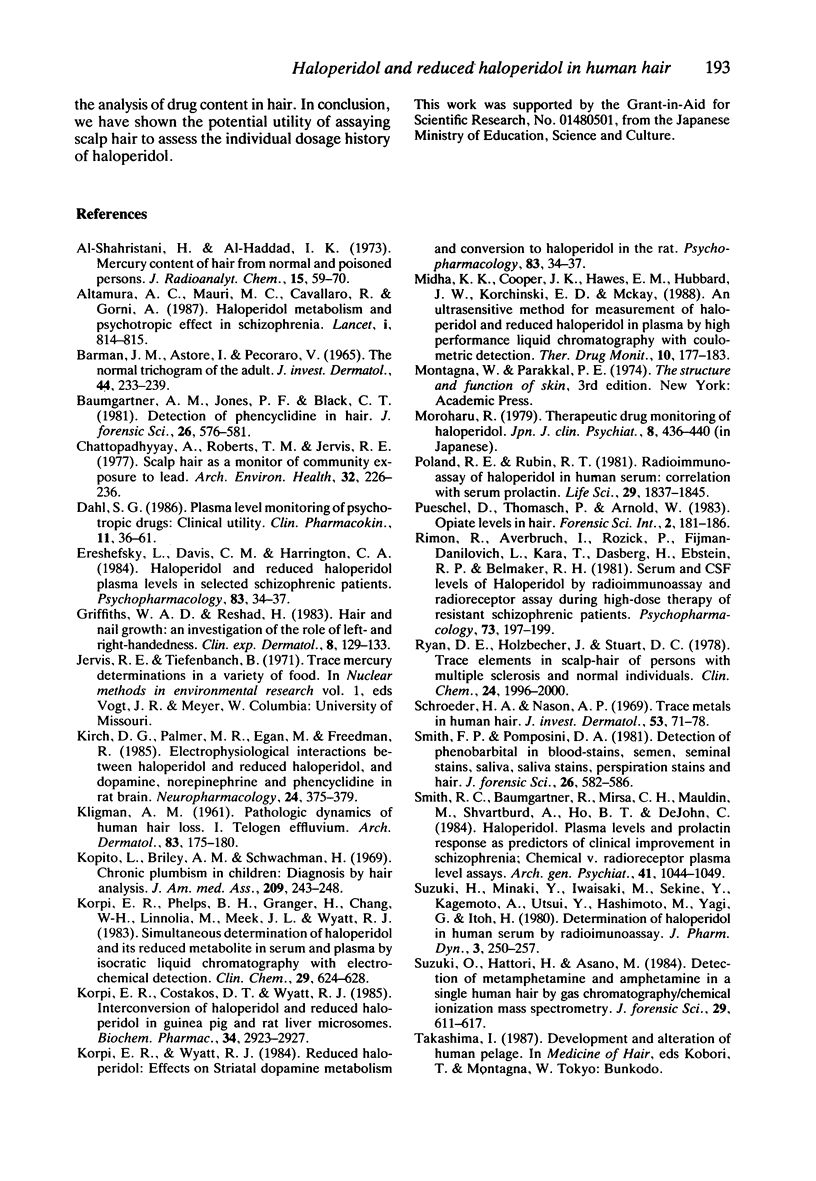
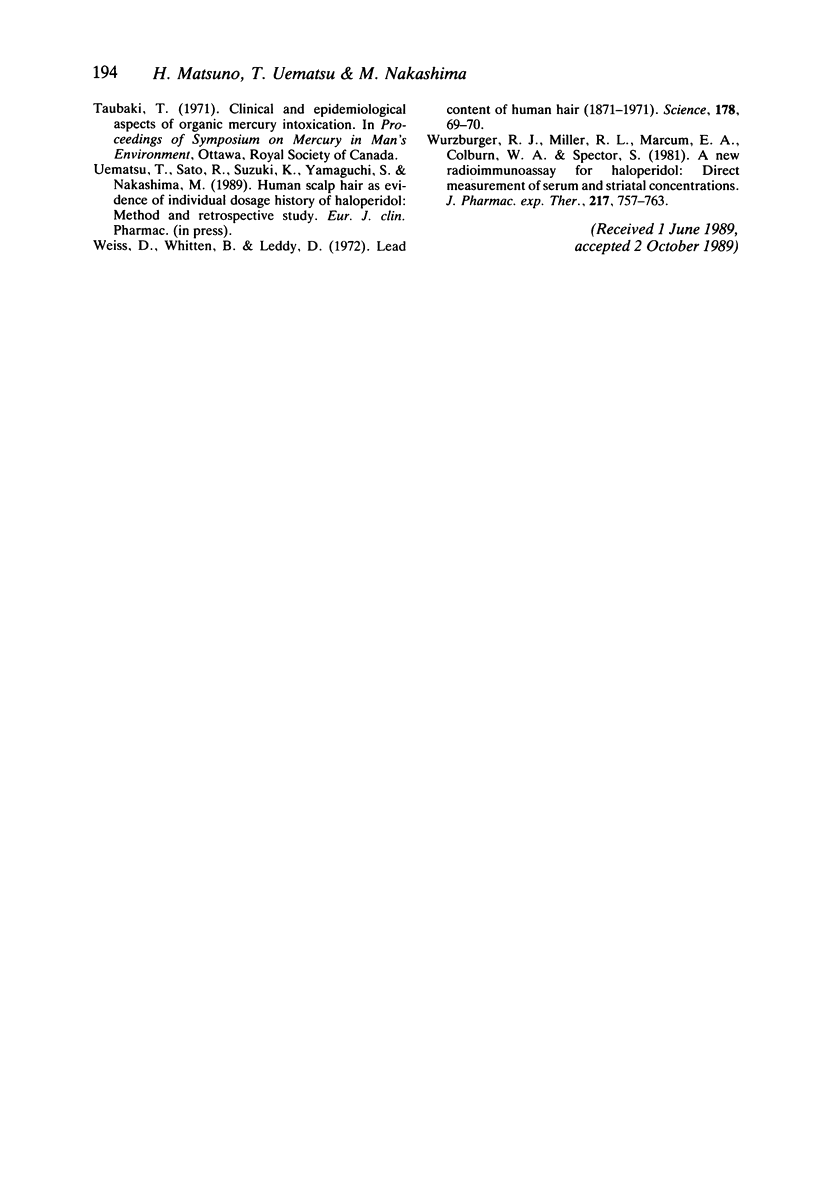
Selected References
These references are in PubMed. This may not be the complete list of references from this article.
- Altamura A. C., Mauri M. C., Cavallaro R., Gorni A. Haloperidol metabolism and antipsychotic effect in schizophrenia. Lancet. 1987 Apr 4;1(8536):814–815. doi: 10.1016/s0140-6736(87)92848-0. [DOI] [PubMed] [Google Scholar]
- BARMAN J. M., ASTORE I., PECORARO V. THE NORMAL TRICHOGRAM OF THE ADULT. J Invest Dermatol. 1965 Apr;44:233–236. doi: 10.1038/jid.1965.42. [DOI] [PubMed] [Google Scholar]
- Baumgartner A. M., Jones P. F., Black C. T. Detection of phencyclidine in hair. J Forensic Sci. 1981 Jul;26(3):576–581. [PubMed] [Google Scholar]
- Chattopadhyay A., Roberts T. M., Jervis R. E. Scalp hair as a monitor of community exposure to lead. Arch Environ Health. 1977 Sep-Oct;32(5):226–236. doi: 10.1080/00039896.1977.10667286. [DOI] [PubMed] [Google Scholar]
- Dahl S. G. Plasma level monitoring of antipsychotic drugs. Clinical utility. Clin Pharmacokinet. 1986 Jan-Feb;11(1):36–61. doi: 10.2165/00003088-198611010-00003. [DOI] [PubMed] [Google Scholar]
- Griffiths W. A., Reshad H. Hair and nail growth: an investigation of the role of left- and right-handedness. Clin Exp Dermatol. 1983 Mar;8(2):129–133. doi: 10.1111/j.1365-2230.1983.tb01756.x. [DOI] [PubMed] [Google Scholar]
- KLIGMAN A. M. Pathologic dynamics of human hair loss. I. Telogen effuvium. Arch Dermatol. 1961 Feb;83:175–198. doi: 10.1001/archderm.1961.01580080005001. [DOI] [PubMed] [Google Scholar]
- Kirch D. G., Palmer M. R., Egan M., Freedman R. Electrophysiological interactions between haloperidol and reduced haloperidol, and dopamine, norepinephrine and phencyclidine in rat brain. Neuropharmacology. 1985 May;24(5):375–379. doi: 10.1016/0028-3908(85)90021-8. [DOI] [PubMed] [Google Scholar]
- Kopito L., Briley A. M., Shwachman H. Chronic plumbism in children. Diagnosis by hair analysis. JAMA. 1969 Jul 14;209(2):243–248. [PubMed] [Google Scholar]
- Korpi E. R., Costakos D. T., Wyatt R. J. Interconversions of haloperidol and reduced haloperidol in guinea pig and rat liver microsomes. Biochem Pharmacol. 1985 Aug 15;34(16):2923–2927. doi: 10.1016/0006-2952(85)90017-6. [DOI] [PubMed] [Google Scholar]
- Korpi E. R., Phelps B. H., Granger H., Chang W. H., Linnoila M., Meek J. L., Wyatt R. J. Simultaneous determination of haloperidol and its reduced metabolite in serum and plasma by isocratic liquid chromatography with electrochemical detection. Clin Chem. 1983 Apr;29(4):624–628. [PubMed] [Google Scholar]
- Korpi E. R., Wyatt R. J. Reduced haloperidol: effects on striatal dopamine metabolism and conversion to haloperidol in the rat. Psychopharmacology (Berl) 1984;83(1):34–37. doi: 10.1007/BF00427418. [DOI] [PubMed] [Google Scholar]
- Korpi E. R., Wyatt R. J. Reduced haloperidol: effects on striatal dopamine metabolism and conversion to haloperidol in the rat. Psychopharmacology (Berl) 1984;83(1):34–37. doi: 10.1007/BF00427418. [DOI] [PubMed] [Google Scholar]
- Midha K. K., Cooper J. K., Hawes E. M., Hubbard J. W., Korchinski E. D., McKay G. An ultrasensitive method for the measurement of haloperidol and reduced haloperidol in plasma by high-performance liquid chromatography with coulometric detection. Ther Drug Monit. 1988;10(2):177–183. doi: 10.1097/00007691-198802000-00011. [DOI] [PubMed] [Google Scholar]
- Poland R. E., Rubin R. T. Radioimmunoassay of haloperidol in human serum: correlation of serum haloperidol with serum prolactin. Life Sci. 1981 Nov 2;29(18):1837–1845. doi: 10.1016/0024-3205(81)90514-2. [DOI] [PubMed] [Google Scholar]
- Püschel K., Thomasch P., Arnold W. Opiate levels in hair. Forensic Sci Int. 1983 Mar-Apr;21(2):181–186. doi: 10.1016/0379-0738(83)90108-1. [DOI] [PubMed] [Google Scholar]
- Rimón R., Averbuch I., Rozick P., Fijman-Danilovich L., Kara T., Dasberg H., Ebstein R. P., Belmaker R. H. Serum and CSF levels of haloperidol by radioimmunoassay and radioreceptor assay during high-dose therapy of resistant schizophrenic patients. Psychopharmacology (Berl) 1981;73(2):197–199. doi: 10.1007/BF00429218. [DOI] [PubMed] [Google Scholar]
- Ryan D. E., Holzbecher J., Stuart D. C. Trace elements in scalp-hair of persons with multiple sclerosis and of normal individuals. Clin Chem. 1978 Nov;24(11):1996–2000. [PubMed] [Google Scholar]
- Schroeder H. A., Nason A. P. Trace metals in human hair. J Invest Dermatol. 1969 Jul;53(1):71–78. [PubMed] [Google Scholar]
- Smith F. P., Pomposini D. A. Detection of phenobarbital in bloodstains, semen, seminal stains, saliva, saliva stains, perspiration stains, and hair. J Forensic Sci. 1981 Jul;26(3):582–586. [PubMed] [Google Scholar]
- Smith R. C., Baumgartner R., Misra C. H., Mauldin M., Shvartsburd A., Ho B. T., DeJohn C. Haloperidol. Plasma levels and prolactin response as predictors of clinical improvement in schizophrenia: chemical v radioreceptor plasma level assays. Arch Gen Psychiatry. 1984 Nov;41(11):1044–1049. doi: 10.1001/archpsyc.1983.01790220034006. [DOI] [PubMed] [Google Scholar]
- Suzuki H., Minaki Y., Iwaisaki M., Sekine Y., Kagemoto A., Utsui Y., Hashimoto M., Yagi G., Itoh H. Determination of haloperidol in human serum by radioimmunoassay. J Pharmacobiodyn. 1980 May;3(5):250–257. doi: 10.1248/bpb1978.3.250. [DOI] [PubMed] [Google Scholar]
- Weiss D., Whitten B., Leddy D. Lead content of human hair (1871-1971). Science. 1972 Oct 6;178(4056):69–70. doi: 10.1126/science.178.4056.69. [DOI] [PubMed] [Google Scholar]
- Wurzburger R. J., Miller R. L., Marcum E. A., Colburn W. A., Spector S. A new radioimmunoassay for haloperidol: direct measurement of serum and striatal concentrations. J Pharmacol Exp Ther. 1981 Jun;217(3):757–763. [PubMed] [Google Scholar]


